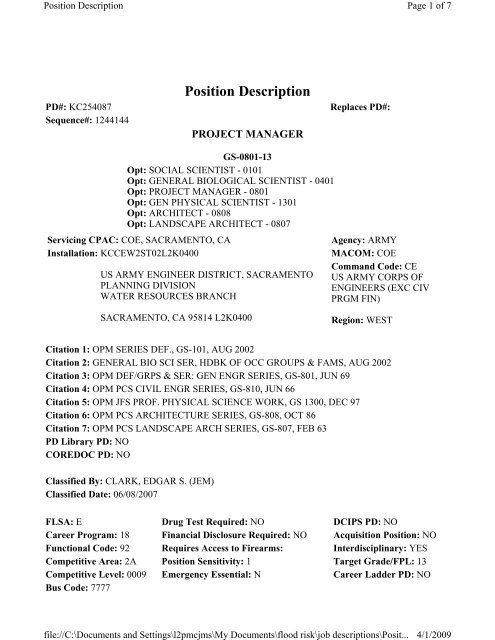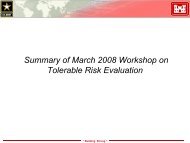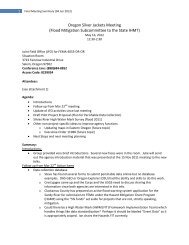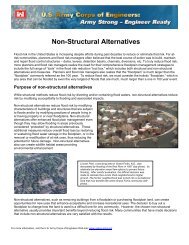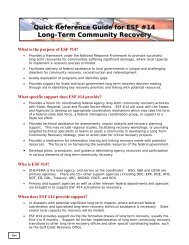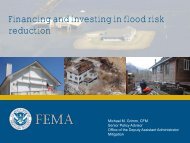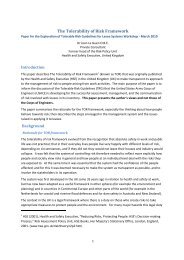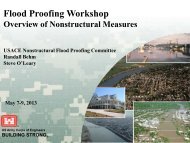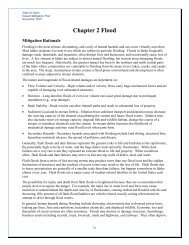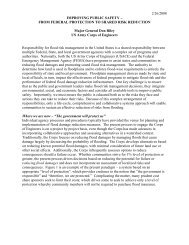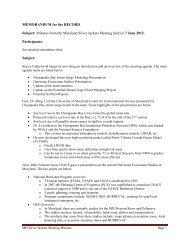Handout for GS-13 - Flood Risk Management Program
Handout for GS-13 - Flood Risk Management Program
Handout for GS-13 - Flood Risk Management Program
You also want an ePaper? Increase the reach of your titles
YUMPU automatically turns print PDFs into web optimized ePapers that Google loves.
Position Description<br />
file://C:\Documents and Settings\l2pmcjms\My Documents\flood risk\job descriptions\Posit...<br />
Page 1 of 7<br />
4/1/2009<br />
PD#: KC254087<br />
Sequence#: 1244144<br />
Position Description<br />
PROJECT MANAGER<br />
Replaces PD#:<br />
<strong>GS</strong>-0801-<strong>13</strong><br />
Opt: SOCIAL SCIENTIST - 0101<br />
Opt: GENERAL BIOLOGICAL SCIENTIST - 0401<br />
Opt: PROJECT MANAGER - 0801<br />
Opt: GEN PHYSICAL SCIENTIST - <strong>13</strong>01<br />
Opt: ARCHITECT - 0808<br />
Opt: LANDSCAPE ARCHITECT - 0807<br />
Servicing CPAC: COE, SACRAMENTO, CA<br />
Installation: KCCEW2ST02L2K0400<br />
US ARMY ENGINEER DISTRICT, SACRAMENTO<br />
PLANNING DIVISION<br />
WATER RESOURCES BRANCH<br />
Agency: ARMY<br />
MACOM: COE<br />
Command Code: CE<br />
US ARMY CORPS OF<br />
ENGINEERS (EXC CIV<br />
PRGM FIN)<br />
SACRAMENTO, CA 95814 L2K0400<br />
Region: WEST<br />
Citation 1: OPM SERIES DEF., <strong>GS</strong>-101, AUG 2002<br />
Citation 2: GENERAL BIO SCI SER, HDBK OF OCC GROUPS & FAMS, AUG 2002<br />
Citation 3: OPM DEF/GRPS & SER: GEN ENGR SERIES, <strong>GS</strong>-801, JUN 69<br />
Citation 4: OPM PCS CIVIL ENGR SERIES, <strong>GS</strong>-810, JUN 66<br />
Citation 5: OPM JFS PROF. PHYSICAL SCIENCE WORK, <strong>GS</strong> <strong>13</strong>00, DEC 97<br />
Citation 6: OPM PCS ARCHITECTURE SERIES, <strong>GS</strong>-808, OCT 86<br />
Citation 7: OPM PCS LANDSCAPE ARCH SERIES, <strong>GS</strong>-807, FEB 63<br />
PD Library PD: NO<br />
COREDOC PD: NO<br />
Classified By: CLARK, EDGAR S. (JEM)<br />
Classified Date: 06/08/2007<br />
FLSA: E Drug Test Required: NO DCIPS PD: NO<br />
Career <strong>Program</strong>: 18 Financial Disclosure Required: NO Acquisition Position: NO<br />
Functional Code: 92 Requires Access to Firearms: Interdisciplinary: YES<br />
Competitive Area: 2A Position Sensitivity: 1 Target Grade/FPL: <strong>13</strong><br />
Competitive Level: 0009 Emergency Essential: N Career Ladder PD: NO<br />
Bus Code: 7777
Position Description<br />
file://C:\Documents and Settings\l2pmcjms\My Documents\flood risk\job descriptions\Posit...<br />
Page 2 of 7<br />
4/1/2009<br />
PD Status: VERIFIED<br />
Duties:<br />
SUPERVISORY CONTROLS<br />
Works under the very general direction of the Chief, Water Resource Section, who provides very<br />
general supervision and assigns work in general terms of overall objectives and results desired.<br />
The incumbent is expected to plan and execute the work under changing project management<br />
parameters. Clears, through supervisor or Project Review Board, plans or decisions to take shortcuts<br />
or to make compromises considered risky or extreme within the context of standard guides,<br />
precedents and techniques. Independently initiates project directives, reports, conferences, etc.,<br />
and represents the organization in negotiations with the client, states, municipal authorities,<br />
interested parties, and local governments. Work is reviewed <strong>for</strong> the attainment of organizational<br />
goals and project results.<br />
MAJOR DUTIES<br />
Provides expert project and program management <strong>for</strong> Corps of Engineers Civil Works <strong>Flood</strong>plain<br />
management services and water resources projects of high dollar value, of national priority, of<br />
environmental sensitivity, of extraordinary urgency, or having similar requirements. Projects may<br />
include flood risk management, floodplain management services, FEMA map coordination, dams,<br />
water diversion structures, bridges, flood walls, levees, river control structures, flood plains,<br />
dredging, environmental restoration and other facilities, or a combination thereof. This requires<br />
that the incumbent apply a wealth of water resources, scientific, FEMA NFIP program and Corps<br />
of Engineers policy and project management knowledge to achieve scheduling, funding and<br />
program goals, and to ensure use of optimum approaches which meet project objectives. Assures<br />
the efficient, effective, and timely accomplishment and coordination of the planning, design and<br />
construction phases. Work is accomplished based on a thorough knowledge of Corps of Engineers<br />
Civil Works water resources program; FEMA NFIP and mapping program knowledge; this<br />
includes interpreting and applying the dynamic and substantive policy relating to Corps of<br />
Engineers Civil Works program and assigned projects, approving operational deviations, applying<br />
innovative contracting procedures, and providing guidance or direction to subordinate project<br />
managers in the section through project oversight activities and interaction. Prepares, presents and<br />
testifies on behalf of the District be<strong>for</strong>e state and local governments, contractors, other agencies,<br />
and Congressional representatives. In addition, coordinates the preparation of the project budget;<br />
the preparation of various cost, milestone, and management reports; and the staffing of internal<br />
and external reviews. Is the districts primary point of contact with the local sponsor throughout a<br />
projects life.<br />
1. (40%) Senior Project Manager. Directs, coordinates and manages the Districts <strong>Flood</strong>plain<br />
management services program. Reviews and evaluates the status of projects <strong>for</strong> attainment of<br />
objectives. Plans, programs and oversees cost and schedule execution of the planning, design, and<br />
construction of Civil Works water resources projects in coordination with the functional chiefs of<br />
each area to assure that the projects are completed within guidelines and objectives. Initiates,<br />
manages, administers and approves plans that translate project objectives into completed<br />
functional phases. Reviews and approves funding and manpower estimates to ensure sufficient<br />
resources to support project objectives. Reviews and approves operating plans and approaches,<br />
establishes overall project priorities, procedures, and short and long range goals. Reviews project<br />
criteria, construction progress, and contract modifications and conceives of and/or approves or
Position Description<br />
file://C:\Documents and Settings\l2pmcjms\My Documents\flood risk\job descriptions\Posit...<br />
Page 3 of 7<br />
4/1/2009<br />
processes the approval of major changes. Evaluates the status of projects against established<br />
milestones and objectives by analyzing in<strong>for</strong>mation presented and directs actions required to<br />
maintain established schedules and to assure the attainment of goals and objectives. Resolves<br />
highly difficult technical and administrative project problems, obtaining Project Review Board or<br />
supervisory approval, as required.<br />
2. (30%) District Representation. Represents the District when dealing with the local, state and<br />
municipal authorities <strong>for</strong> the project and is responsible <strong>for</strong> furnishing authoritative responses to<br />
program and project questions and issues. Speaks with the authority of the Chief of Planning<br />
Division at conferences and with the press on all issues including those of a critical or<br />
controversial nature arising during the life of the project and program.<br />
3. (30%) Plans and Guidance. Participates with key district personnel in defining project goals and<br />
in pre-paring a master plan <strong>for</strong> accomplishment. Make major plans and programming decisions<br />
that effect long and short-range courses of critical action <strong>for</strong> the projects. Serves as the<br />
authoritative source <strong>for</strong> decisions and guidance dealing with compromises and changes in program<br />
and project objectives. Implements overall program and project guidance and policy. Adapts and<br />
interprets policy to assure a uni<strong>for</strong>m and balanced program and project within the framework of<br />
District policies, programs, and objectives. Assures that the projects incorporate the most<br />
advanced science and technology and that they are structured, staffed and managed to be<br />
responsive to requirements. Establishes the technical framework and guidance <strong>for</strong> accomplishment<br />
of objectives within the District's in-house and contractual capabilities. For projects to be<br />
evaluated or designed out-house or by architect-engineer firms, PM manages those project work<br />
products.<br />
Per<strong>for</strong>m other duties as assigned.<br />
Special Requirements:<br />
Incumbent may be required to per<strong>for</strong>m temporary duty travel (TDY) approximately 20-40% of the<br />
time in connection with stated duties.<br />
Incumbent may be required to possess or obtain a valid drivers license.<br />
Evaluation:<br />
NOTE: Architect,<strong>GS</strong>-0808 discipline added 8/6/01 per MG Hans Van Winkle memo, Subject:<br />
Inclusion of <strong>GS</strong>-808 Architects when Classifying and Recruiting Interdisciplinary Positions. Rene<br />
Valenzuela<br />
NOTE: Application of OPM JFS <strong>for</strong> Professional Physical Science Work <strong>GS</strong>-<strong>13</strong>00P, Oct 97<br />
results in change to the title <strong>for</strong> the <strong>13</strong>01 discipline. The title prescribed by the JFS is "Physical<br />
Scientist"; there is no impact on the grade. Nicole Smith 12/05/00<br />
EVALUATION STATEMENT<br />
Job Number: K4012<br />
CL: 009; CL: FOR <strong>GS</strong>-0808 = 0007<br />
1. References:<br />
a. US OPM PCS Series Definition <strong>for</strong> Social Scientist, <strong>GS</strong>-0101, Sep 93<br />
b. US OPM PCS Series Definition <strong>for</strong> General Biology, <strong>GS</strong>-0401, Sep 93<br />
c. US OPM PCS Series Definition <strong>for</strong> General Engineering, <strong>GS</strong>-0801,
Position Description<br />
file://C:\Documents and Settings\l2pmcjms\My Documents\flood risk\job descriptions\Posit...<br />
Page 4 of 7<br />
4/1/2009<br />
Sep 93<br />
d. US OPM PCS Civil Engineering Series, <strong>GS</strong>-810, Part IV, Jun 66 (<strong>for</strong> grade determination as<br />
issued by HQ USACE, Aug 98).<br />
e. d. OPM PCS LANDSCAPE ARCH SERIES, <strong>GS</strong>-807, FEB 63<br />
2. Background. In August 1998, HQ USACE issued model job descriptions (JDs) and evaluation<br />
statements <strong>for</strong> project management positions located in District PPM Divisions. The new JDs<br />
reflect the Chief Engineer's vision of an interdisciplinary project management work<strong>for</strong>ce that can<br />
effectively management diverse, challenging projects. The interdisciplinary nature of the JDs<br />
improves management flexibility by enabling positions to be filled with qualified individuals in<br />
various professional occupational series, including the social sciences, biological sciences,<br />
engineering, and the physical sciences. The HQ USACE model JD has been applied to subject<br />
position and replaces the existing JD <strong>for</strong> project managers. The HQ USACE model evaluation<br />
statement has also been applied to the position, as follows.<br />
3. Series Determination. The Project Manager (PM) in the Corps of Engineers is responsible <strong>for</strong><br />
managing the project from planning to completion. The PM integrates all the processes and<br />
functions involved in the project, including planning, engineering, design, construction, and other<br />
technical functions. The position must coordinate actions and decisions with these elements,<br />
resolving conflicts and settling issues arising by dealing with technical managers who are<br />
responsible <strong>for</strong> their technical phase of the project. The PM is responsible <strong>for</strong> the overall quality of<br />
the project, assuring that the technical quality meets the expectations of the customer. In addition,<br />
the PM is responsible <strong>for</strong> assuring that the project meets schedule, cost and scope objectives<br />
established through negotiations with the customer and included in the Project <strong>Management</strong> Plan.<br />
This involves coordination and negotiation with customers and political entities affected by or<br />
affecting the project. The PM allocates funds to all elements of the project and assures that costs<br />
do not exceed projected allocations. The PM is the primary point of contact between the District<br />
and external entities affected by the project. He/she manages through a matrix management<br />
process, controlling schedules and costs while individuals involved are supervised by their<br />
technical elements.<br />
Normally positions are classified to the series of the predominant skill requirement. In the case of<br />
the Corps of Engineers PM, historical recruitment practices and recent skills analysis reveal the<br />
need <strong>for</strong> a broad base of scientific and professional knowledge, coupled with experience in the<br />
administrative aspects of project management. Further, the Chief Engineer has mandated that PM<br />
positions be classified as interdisciplinary to enable a professionally diverse work<strong>for</strong>ce and<br />
because individuals with training and experience in any of the allocated disciplines may be<br />
considered to be equally qualified to per<strong>for</strong>m the work. The position, there<strong>for</strong>e, is classified as<br />
"Interdisciplinary" and remains so as long as it is vacant. The final series of the position is<br />
determined by the personal qualifications of the individuals who fill it. HQ USACE recommended<br />
a number of professional/scientific series that would be appropriate <strong>for</strong> subject position. However,<br />
local management has decided to focus on four primary occupational groups that will provide a<br />
fairly sizable recruiting base and allow qualified candidates to successfully compete <strong>for</strong> the<br />
position. Thus, subject position may be allocated to any of the following series, depending upon<br />
the qualifications of the incumbents: <strong>GS</strong>-0101 (Social Science), <strong>GS</strong>-0401 (Biological Science),<br />
<strong>GS</strong>-0801 (Engineering), and <strong>GS</strong>-<strong>13</strong>01 (Physical Science), <strong>GS</strong>-810 (Civil Engineer), <strong>GS</strong>-807<br />
(LANDSCAPE ARCHITECT).<br />
4. Title Determination. Because the position can be allocated to general series that represent broad<br />
occupational groups, specific titling criteria is not prescribed. Consequently, the constructed title
Position Description<br />
file://C:\Documents and Settings\l2pmcjms\My Documents\flood risk\job descriptions\Posit...<br />
Page 5 of 7<br />
4/1/2009<br />
of Project Manager is considered appropriate <strong>for</strong> the position, regardless of series, as it fully<br />
represents the nature of work per<strong>for</strong>med.<br />
5. Grade Determination. (The following grade determination analysis is provided by HQ USACE,<br />
reference 1.d).<br />
a. DETERMINATION OF STANDARD.<br />
In absence of a directly applicable standard <strong>for</strong> measurement of matrix management, <strong>GS</strong>-810, Part<br />
IV is determined to be appropriate <strong>for</strong> comparison. The standard measures the job by three factors,<br />
scope and complexity of facilities, range of facilities engineering and level of responsibility.<br />
While the standard is written to apply to "constructed facilities", it is intended to measure<br />
positions "which may have responsibility pertaining to any or all phases of the engineering of<br />
facilities, such as the following: initiation of technical and economic feasibility studies,<br />
development of proposals <strong>for</strong> work and budget approval, planning and design, construction, and<br />
maintenance." Subject job, in per<strong>for</strong>ming the full range of project management, transcends these<br />
functions and can be measured by application of the standard with due consideration <strong>for</strong> those<br />
matrix management responsibilities not measured by the standard.<br />
b. APPLICATION OF STANDARD.<br />
Scope and Complexity of Facilities:<br />
(1) The scope and technological characteristics of the facilities: The facilities <strong>for</strong> which the project<br />
manager has responsibility are complicated by major technical engineering issues, representing a<br />
high incidence requirement <strong>for</strong> special equipment, materials, and design features. These include<br />
major river facilities including multipurpose dams, levees, bypasses, channels, floodwalls, water<br />
systems, diversions, and pumping plants, and appurtenant recreation facilities, relocations, rightsof-way,<br />
borrow and disposal of materials, and operations and maintenance aspects. For<br />
environmental projects, facilities may include wetlands development, fish and wildlife habitat<br />
plantings, grading, power and irrigation, ground and water quality provisions, and appurtenant<br />
operations and maintenance facilities. These facilities are characteristic of those described at the<br />
<strong>GS</strong>-<strong>13</strong> level in the standard in example 2, p. 63: The projects included range from local<br />
protection works (such as levees and channel improvements) to major multiple purpose projects<br />
(usually including facilities <strong>for</strong> power production, flood control, navigation, water supply, fish and<br />
wildlife preservation and recreation).<br />
(2) Number and diversity of organizations involved: There is an extensive diversity/number of<br />
organizations involved in the management of projects. These include multiple local<br />
sponsors /customers, Federal, state and local government agencies, business and industry groups<br />
and private citizens. This extensive diversity/number clearly meets example 1 <strong>for</strong> the <strong>GS</strong>-<strong>13</strong> level,<br />
p. 62 and example 2, p. 63.<br />
(3) Range of jurisdictional control over facilities: The projects managed involve a complicated<br />
maze of jurisdictional controls with frequently conflicting interests of Federal, state and local<br />
government agencies. Civil and environmental projects involve other Federal agencies (Energy,<br />
Interior, Agriculture, Transportation, Commerce, and others), a multitude of<br />
state/county/municipal and multi-county water control and/or conservation district<br />
customers/sponsors. These extensive jurisdictional relationships involving multiple<br />
sponsors/customers and/or extending over a considerable geographic area substantially meet<br />
examples 1 and 2 <strong>for</strong> the <strong>GS</strong>-<strong>13</strong> level, p. 62-63: ..responsible <strong>for</strong> program development, control<br />
and conservation, in a watershed area covering portions of several states." Although some projects
Position Description<br />
file://C:\Documents and Settings\l2pmcjms\My Documents\flood risk\job descriptions\Posit...<br />
Page 6 of 7<br />
4/1/2009<br />
are within the boundaries of one state (e.g., Cali<strong>for</strong>nia), the multitude of agency/county/local<br />
jurisdictional controls are significantly more extensive than an entire region of several states.<br />
(4) Degree of urgency and/or public interest associated with projects or programs: Projects involve<br />
a high degree of urgency and public interest. Projects normally impact the local economy and<br />
frequently affect the economy of a sizable geographic or population area. This urgency and<br />
interest requires the project manager to obtain the cooperation of other agencies and state/local<br />
government entities, frequently defend current schedules and funding and make decisions<br />
involving judgments based on significant experience. The nature of this urgency and public<br />
interest somewhat exceeds examples 1 and 2 at the <strong>GS</strong>-<strong>13</strong> level pp. 62-63: "The engineer must<br />
provide guidance and in<strong>for</strong>mation to, and obtain the cooperation of officials of the military agency<br />
served, a variety of governmental officials and groups in the states and localities that have<br />
jurisdiction over economic planning, land use, utilities operations and services in areas where<br />
facilities are located..." and "The engineer must consider and coordinate many elements relating to<br />
budget and funds requirements and availability of engineering resources."<br />
Based on comparison to cited examples, Scope and Complexity of Facilities is determined to fully<br />
meet the <strong>GS</strong>-<strong>13</strong> level.<br />
Range of Facilities Engineering Activities Managed: The range of facilities engineering activities<br />
managed includes the phases of planning, developing, designing, constructing, and directing<br />
engineering projects of considerable scope and complicated by their diversity, geographical area,<br />
management demands, technical intricacies, and public issues. This range of activities clearly<br />
meets the <strong>GS</strong>-<strong>13</strong> level as described in p. 61, "The <strong>GS</strong>-<strong>13</strong> level is typified by full responsibility <strong>for</strong><br />
development and/or coordination over a broad range of facilities engineering activities, covering a<br />
variety of complex facilities in a sizable geographic area." Subject job substantially exceeds the<br />
description <strong>for</strong> the <strong>GS</strong>-12 level described at p. 59, in which the range of activities is limited to<br />
construction, "At the operating level of a construction agency, coordinates construction activities<br />
<strong>for</strong> a few large projects (such as <strong>for</strong> a multiple purpose dam, power plant, reservoir, and associated<br />
relocation and construction of utilities and community facilities) or <strong>for</strong> an extensive group of<br />
smaller projects (such as levees, channel improvements, bank stabilization, flood control<br />
reservoirs, and floodways)."<br />
Based on comparison to cited examples, the range of facilities is determined to fully meet the <strong>GS</strong>-<br />
<strong>13</strong> level.<br />
Level of Responsibility: Subject job manages projects in a District. This is determined to meet<br />
definitions of "operating level" in a "construction agency". The project manager applies an<br />
extensive knowledge of management concepts, principles, methods and practices as well as<br />
methods, practices and processes of engineering and science disciplines. The project manager is<br />
fully responsible <strong>for</strong> projects managed and carries out assignments subject to review <strong>for</strong> achieving<br />
results. This level of responsibility meets the <strong>GS</strong>-<strong>13</strong> level as described in p. 61, "The <strong>GS</strong>-<strong>13</strong><br />
engineer receives assignments on the basis of recognized competence, demonstrated through<br />
considerable experience related to the area of assignment. He is subject to very general<br />
supervision, his work being judged mainly <strong>for</strong> achievement of productive results."<br />
Based on comparison to cited example, the level of responsibility is determined to fully meet the<br />
<strong>GS</strong>-<strong>13</strong> level.<br />
c. CONCLUSION. Based on the determination that the scope and complexity of facilities <strong>for</strong><br />
which the job has engineering management responsibility, the range of facilities engineering
Position Description<br />
file://C:\Documents and Settings\l2pmcjms\My Documents\flood risk\job descriptions\Posit...<br />
Page 7 of 7<br />
4/1/2009<br />
activities managed and the level of responsibility assigned all fully meet the <strong>GS</strong>-<strong>13</strong> level described<br />
in cited standard, the job is graded at <strong>GS</strong>-<strong>13</strong> level.<br />
6. Final Determination. Subject position is properly classified as Project Manager, <strong>GS</strong>-XXXX-<strong>13</strong>,<br />
and may be allocated to any of the following series: 0101, 0401, 0801, <strong>13</strong>01.


